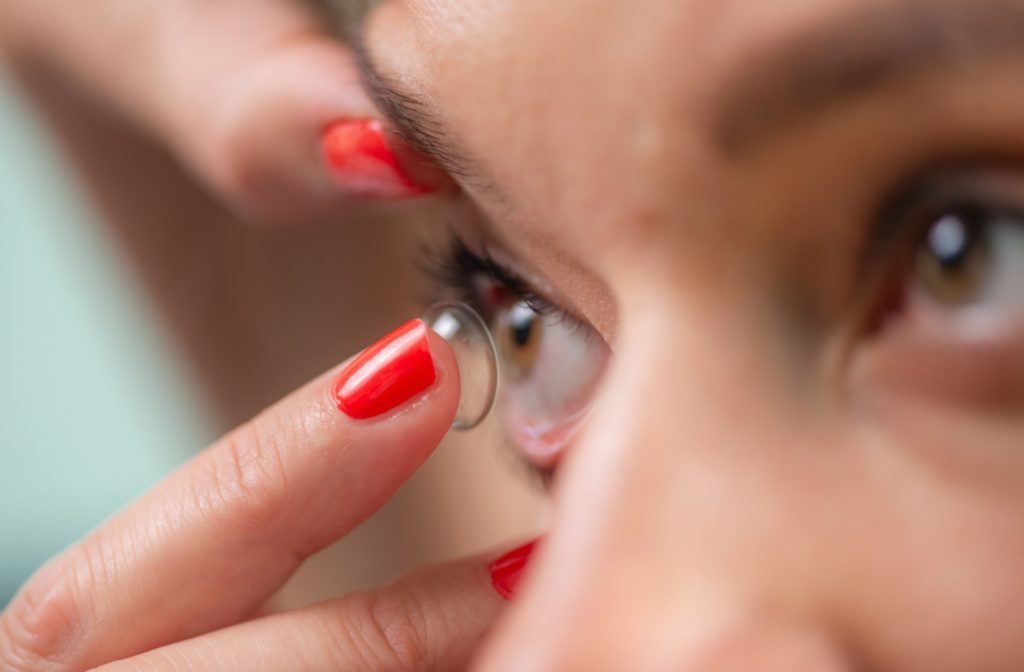Contact lenses are one of the most popular ways to correct vision. They offer ongoing convenience and a wide field of vision, and they can be more comfortable than traditional eyeglasses.
While the benefits of contacts are appealing, they require more maintenance and care than glasses, necessitating a contact lens fitting.
A fitting helps your optometrist determine the most suitable contact lens for your lifestyle and visual needs.
During a contact lens fitting, you’ll get:
- Measurements of your eyes
- An assessment of your eye’s corneal surface and tear film
- A contact lens trial period
- A finalized contact lens prescription
Importance of Contact Lens Fittings
A contact lens fitting is an important component of an annual contact lens exam.
This portion of the appointment allows your optometrist to carefully evaluate how contact lenses will interact with your eyes. Your optometrist will want to know that your contacts fit properly, comfortably, and securely.
During a fitting, your optometrist takes numerous measurements of your eyes, including the curvature of your cornea and the diameter of the eye’s surface. These measurements will help you find a lens that aligns well with the shape and size of your eye.
The fitting also allows your optometrist to examine the health of your eyes and determine whether they’re healthy enough to continue wearing lenses.
A contact lens fitting is a requirement for anyone wishing to renew their contact lens prescription. Those who are experienced contact lens wearers may assume that, since they’re happy with one particular kind or brand of lens, that adjustments aren’t necessary.
This isn’t true—our eyes are always evolving. They change over time due to natural ongoing factors like age, lifestyle, vision changes, and health conditions. All of these influence the fit of the lens.
Reassessing your lens fit can catch minor issues, letting you and your optometrist adjust your lens prescription and fit before they become concerns.
Problems of Ill-Fitting Contacts
Our eyes come in different shapes and sizes, and so do contact lenses.
A properly fitted contact lens will fit snugly and securely over the eye’s corneal surface. Wearing ill-fitting contact lenses, on the other hand, can lead to complications.
If lenses are too tight, they may restrict oxygen flow to the cornea, causing irritation or corneal swelling. Loose lenses can shift around the eye, leading to discomfort and inconsistent vision. Both scenarios increase the risk of eye infections.
Just because your optometrist raises concerns during your appointment doesn’t mean that you have to give up on contacts. It just means that we’ll need to address the underlying concern through a treatment and management plan before you continue wearing contacts.

What to Expect at Your Contact Lens Fitting Appointment
A contact lens appointment isn’t anything to worry about, but knowing what to expect during the appointment can help ease any uncertainty regarding the visit.
A contact lens fitting is usually accompanied by your annual contact lens exam. This routine exam is similar to a comprehensive exam for glasses, though note that there is a slight difference between prescriptions for glasses and contacts.
Eye Measurements
Your optometrist will begin by taking precise measurements of your eyes using specialized tools. This helps to find the contact lens most suitable for your eye’s shape and size, including:
- Corneal curvature
- Pupil size
- Iris diameter
Ocular Health Assessment
As part of your fitting, your ocular health and tear film are carefully examined. We want to make sure that everything is working as intended and that contact lenses are right for you.
Your eyelids and lashes are assessed to look for any signs of conditions like blepharitis or meibomian gland dysfunction, both of which can affect lens comfort and eye health.
The ocular surface and corneal health of the eye are checked for any signs of irritation, redness, abnormal growth, or dryness.
The quality of the tear film and production of tears is also assessed as tears help lubricate and nourish the eyes while the lenses are worn. If the quality of tear production appears low or the corneal surface looks relatively dry, your optometrist will suggest dry eye therapies to keep the eye’s surface nice and hydrated.
Trial Period
Next, you’ll try the lenses. If you’re a new contact lens wearer, your optometrist will guide you through the insertion and removal process, offering trips to help find the most comfortable, safe, and efficient techniques.
You’ll also receive instructions on the proper care and maintenance of your new lenses. This includes cleaning, storage, and replacement schedules to minimize the risk of infections or complications.
Once the trial lenses are in place, you’ll be asked to wear them for a short period to examine how securely they fit over your eyes. Your optometrist will check to make sure the lenses don’t shift excessively as you move your eyes, and that they provide clear and stable vision.
If the lenses appear to fit well and provide good visual clarity, you’ll be asked to wear them for a short period (about a week or so) to see how well the vision and fit hold up during day-to-day activities.
Finalized Prescription
During the follow-up appointment, the fit, vision, and comfort of the lenses are assessed one last time.
If you and your optometrist are satisfied with the lenses, your prescription will be finalized, which allows you to order a supply of contact lenses.
Schedule a Visit
A contact lens fitting is necessary for confirming the comfort, fit, and vision correction of your contact lenses.Connect with our team at Rancho Santa Margarita Optometry to schedule an appointment for your own contact lens fitting!


